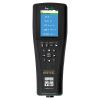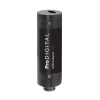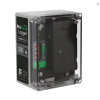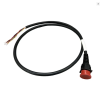YSI ProSwap Logger
Features
- User-replaceable water quality sensors alongside built-in temperature and depth
- Smart sensor technology with on-board monitoring for improved calibration and performance
- Titanium housing and waterproof connectors guarantee operation well into the future
- Free ground shipping
- Expedited repair and warranty service
- Lifetime technical support
- More
Monitoring Made Simple
ProSwap Logger features a universal port for a wide variety of real-time monitoring applications. Combine any digital smart sensor with the built-in temperature and depth sensors for more comprehensive measurements in a slim profiling package. Build a dedicated system for conductivity, dissolved oxygen, pH, turbidity, or algae monitoring applications with unique customization options.
Continuous Unattended Logging
Ideal for short- and long-term deployments, the on-board memory is capable of holding over 100,000 data sets. With ProSwap Logger, you can view trends in water quality over extended periods of time for a true representation of the ecosystem.
Flexible Deployment
ProSwap Logger is a powerful instrument in a small package. Suspend in groundwater wells, deployment pipes, and other tight or shallow spaces. A variety of power and deployment options are available to fit the needs of your system.
Reliable Connection
An integral cable allows for easy topside communication and data download without removing the sonde from its deployment location. A twist-lock connector provides quick and reliable communication via a dedicated handheld or Kor Software. With convenient options for calibration, deployment setup, and data collection, ProSwap Logger makes it easier than ever to effectively expand you smart watershed.
Digital Smart Sensors
ProSwap Logger is compatible with any individual ProDSS Digital Smart Sensor for fast, easy setup and high quality data. Each sensor features a welded titanium body, auto-recognition, and local storage of calibration for quick swapping. Trusted by water quality professionals, these sensors provide accurate data with advanced technology and proven performance!
| Material | 512 MB, >100,000 data sets (includes date, time, site, parameters) |
| Software |
Kor Software |
| Communications | Sonde: YSIP, SDI-12, Modbus* Adapters: USB, Flying-Lead |
| Power |
External Powering: 5.4 - 16V |
| Operating Temp. |
-5 to 50°C (23 to 122°F) |
| Storage Temperature | -20 to 50°C (-4 to 122°F) |
|
Depth Rating |
0 to 100 m (0 to 328’) |
| Battery Life |
≥ 90 days at 15 min log interval |
| Sampling Rate | 1 per second (fastest) to 1 per day (slowest) |
| Diameter | 2.65 cm (1.05”) |
| Length (with guard) without Battery | 49.70 cm (19.57”) |
| Length (with guard) with Battery | 57.35 cm (22.58”) |
| Sonde Weight** with Battery |
0.57 kg (1.25 lbs) |
| Sonde Weight** without Battery | 0.45 kg (0.99 lbs) |
| Warranty |
2 Years |
*Modbus output configurable with post-launch update
**Total weight will depend on cable length
- ProSwap Logger with Integrated Cable
- Probe Guard
- Weight (for Probe Guard)
- Storage Sleeve
- Sponge
- Graduated Cylinder
- USB Drive (contains Kor Software)
- Cable Connector Cap
- Cable Grip Kit
- Cable Management Kit (4m, 10m, 20m) or Cable Spool (30m+)
- Maintenance Kit
- Desiccant Kit (Vented units ONLY)
In The News
Monitoring Mariculture in the Gulf of Alaska
The mariculture industry in the Gulf of Alaska has been steadily growing in recent years, guided by ongoing research to help refine farm location and cultivation practices. A subset of aquaculture, mariculture focuses on rearing organisms in the open ocean. In Alaska, finfish farming is illegal, so most farms cultivate kelp, oysters, or a combination of the two. These small, locally operated farms started popping up in the Gulf of Alaska in the early 1990s, when shellfish farming first became legal. Kelp farming did not begin to catch on in the state until 2016. Many of the coastal areas that have grown interested in mariculture are historically commercial fishing communities.
Read MoreSupplying Seattle’s Drinking Water: Using Data Buoys to Monitor the Cedar River Municipal Watershed
Providing clean, safe, and reliable drinking water for the 1.6 million people in the greater Seattle area is a top priority for Seattle Public Utilities (SPU). With limited water supplies, SPU dedicates considerable resources to maintain its watersheds and mountain reservoirs. About 70 percent of Seattle Water comes from the Cedar River Municipal Watershed , and the other 30 percent comes from the South Fork Tolt River Watershed . [caption id="attachment_39574" align="alignnone" width="940"] Data buoy in Chester Morse Lake . (Credit: Kevin Johnson / Seattle Public Utilities) [/caption] Jamie Thompson, a fisheries biologist at SPU, monitors aquatic ecosystems centered on fish listed under the U.S. Endangered Species Act (ESA).
Read MoreData-Driven Advocacy on the Lower Deschutes River
Like many freshwater environments, the Deschutes River in Oregon is under pressure from development, pollution, and climate change. Many rivers, streams and lakes in the Deschutes Basin do not meet Oregon water quality standards –where state water quality monitoring assesses levels of bacteria, pH, dissolved oxygen, temperature, and fine sediment. Hannah Camel is the Water Quality Coordinator for the Deschutes River Alliance (DRA), a non-profit organization that focuses on the health of the lower 100 miles of the Deschutes River–the area most affected by human intervention. As a data-driven organization, the DRA has benefited from the installation of two NexSens X2 data loggers.
Read More


















































